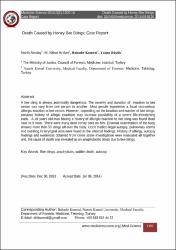| dc.contributor.author | Anolay, Nezih | |
| dc.contributor.author | Arslan, M. Nihat | |
| dc.contributor.author | Kumral, Bahadır | |
| dc.contributor.author | Büyük, Yalçın | |
| dc.date.accessioned | 2022-05-11T14:37:03Z | |
| dc.date.available | 2022-05-11T14:37:03Z | |
| dc.date.issued | 2014 | |
| dc.identifier.issn | 2147-0634 | |
| dc.identifier.issn | 2147-0634 | |
| dc.identifier.uri | https://app.trdizin.gov.tr/makale/TWpNM01UTXhNUT09 | |
| dc.identifier.uri | https://hdl.handle.net/20.500.11776/8553 | |
| dc.description.abstract | A bee sting is always potentially dangerious. The severity and duration of reaction to bee venom can vary from one person to another. Most people experience a local non-serious allergic reaction to bee venom. However, depending on the location and number of bee stings, previous history of allegic reactions may increase possibility of a severe life-threatening evets. A 49 years old man having a history of allergic reaction to bee sting was found dead near to 9 nests. There were many dead honey bees on him. External examination of the body showed more than 50 stings all over the body. Upon medico-legal autopsy, pulmonary edema and swelling in laryngeal area were found as the internal findings. History of allergy, autopsy findings and evedences obtained from crime scene investigation were evaluated all together and, the cause of death was revealed as an anaphylactic shock due to bee stings | en_US |
| dc.language.iso | eng | en_US |
| dc.rights | info:eu-repo/semantics/openAccess | en_US |
| dc.subject | Genel ve Dahili Tıp | en_US |
| dc.title | Death Caused by Honey Bee Stings: Case Report | en_US |
| dc.type | article | en_US |
| dc.relation.ispartof | Medicine Science | en_US |
| dc.department | Fakülteler, Tıp Fakültesi, Dahili Tıp Bilimleri Bölümü, Adli Tıp Ana Bilim Dalı | en_US |
| dc.identifier.volume | 3 | en_US |
| dc.identifier.issue | 2 | en_US |
| dc.identifier.startpage | 1305 | en_US |
| dc.identifier.endpage | 1314 | en_US |
| dc.institutionauthor | Kumral, Bahadır | |
| dc.identifier.trdizinid | TWpNM01UTXhNUT09 | en_US |



















